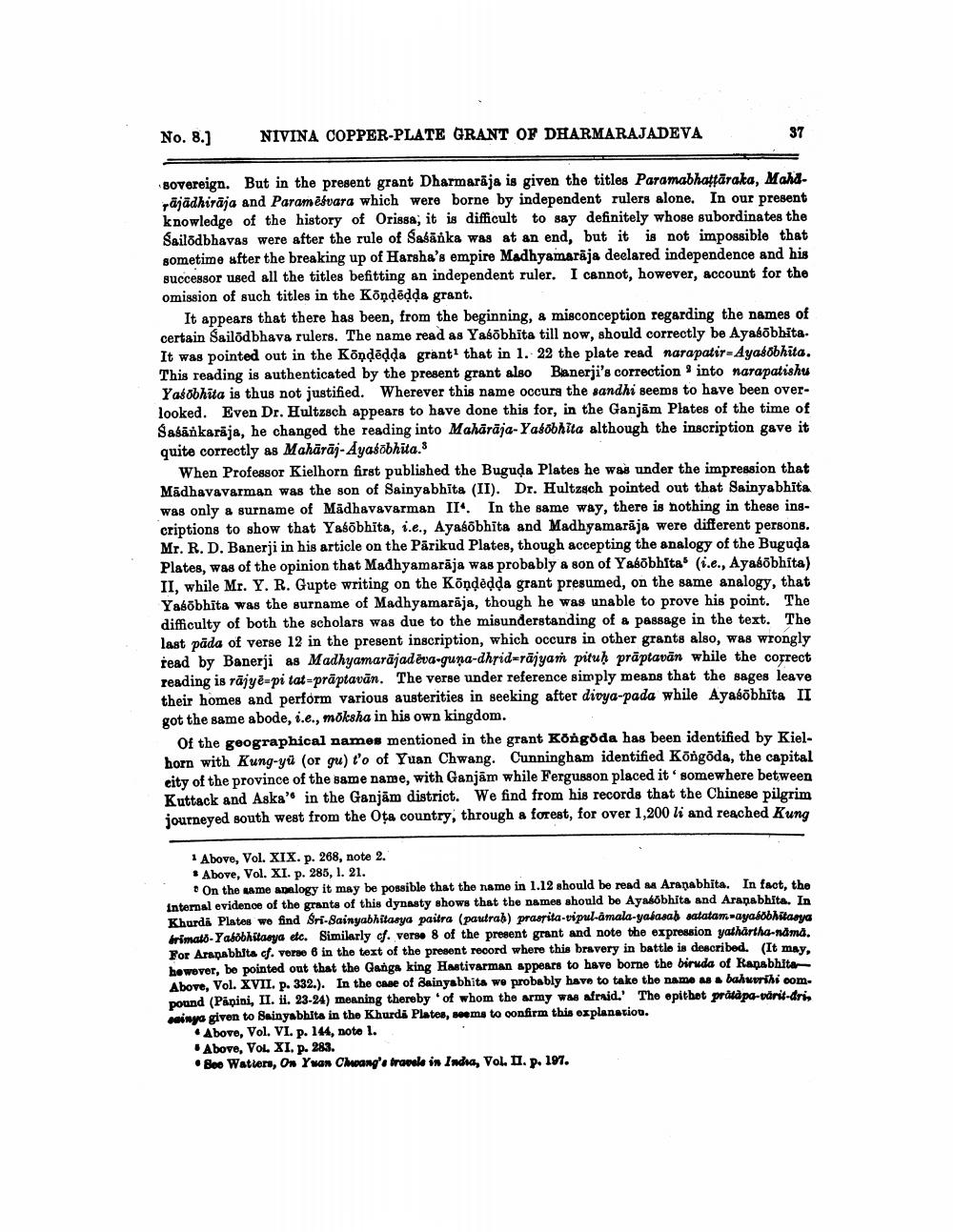________________
No. 8.)
NIVINA COPPER-PLATE GRANT OF DHARMARAJADEVA
37
Bovereign. But in the present grant Dharmarāja is given the titles Paramabhaftāraka, Mahdmājādkirāja and Paramédvara which were borne by independent rulers alone. In our present knowledge of the history of Orissa, it is difficult to say definitely whose subordinates the Sailodbhavas were after the rule of Sabanka was at an end, but it is not impossible that sometime after the breaking up of Harsha's empire Madhyamarāja declared independence and his successor used all the titles befitting an independent ruler. I cannot, however, account for the omission of such titles in the Köņdēdda grant.
It appears that there has been, from the beginning, & misconception regarding the names of certain Sailodbhava rulers. The name read as Yaśābhīta till now, should correctly be Ayasõbhita. It was pointed out in the Köndēdda grant that in 1. 22 the plate read narapatir-Ayasobhita. This reading is authenticated by the present grant also Banerji's correction into narapatishu Yasobhita is thus not justified. Wherever this name occurs the sandhi seems to have been overlooked. Even Dr. Hultzsch appears to have done this for, in the Ganjam Plates of the time of Sasānkarāja, he changed the reading into Mahārāja-Yafobhita although the inscription gave it quite correctly as Mahārāj- Ayasõbhita.
When Professor Kielhorn first published the Buguda Plates he was under the impression that Madhavavarman was the son of Sainyabhita (II). Dr. Hultzsch pointed out that Sainyabhita was only a surname of Madhavavarman II. In the same way, there is nothing in these ingcriptions to show that Yasõbhita, i.e., Ayasõbhita and Madhyamarāja were different persons. Mr. R. D. Banerji in his article on the Pärikud Plates, though accepting the analogy of the Buguda Plates, was of the opinion that Madhyamarāja was probably & son of Yabobhita (i.e., Ayasobhita) II. while Mr. Y. R. Gupte writing on the Köņdedda grant presumed, on the same analogy, that Yabōbhita was the surname of Madhyamarāja, though he was unable to prove his point. The difficulty of both the scholars was due to the misunderstanding of a passage in the text. The last pada of verse 12 in the present inscription, which occurs in other grants also, was wrongly tead by Banerji as Madhyamarājadeva-guna-dheid=rājyan pituh prāptavān while the correct reading is rājye-pi tat-prāptavān. The verse under reference simply means that the sages leave their homes and perform various austerities in seeking after didya-pada while Ayaśābhīta II got the same abode, i.e., moksha in his own kingdom.
of the geographical names mentioned in the grant Kongoda has been identified by Kielhorn with Kung-yü (or gu) t'o of Yuan Chwang. Cunningham identified Köngöds, the capital city of the province of the same name, with Ganjām while Fergusson placed it somewhere between Kuttack and Aska' in the Ganjām district. We find from his records that the Chinese pilgrim journeyed south west from the Ota country, through a forest, for over 1,200 li and reached Kung
1 Above, Vol. XIX. p. 268, note 2. * Above, Vol. XI. p. 285, 1. 21.
On the same analogy it may be possible that the name in 1.12 should be read sa Aranabhita. In fact, the Internal evidence of the grants of this dynasty shows that the names should be Ayabobhita and Aranabhita. In Khurda Plates wo find Sri-Sainyabhitasya paitra (paudrab) prassita-vipul-amala-yakasal aatatan-ayakobhitanya trimato-Yałöbhitarya etc. Similarly cf. verse 8 of the present grant and note the expression yathartha-ndma. For Aranabhita cf. verse 6 in the text of the present record where this bravery in battle is described. (It may, however, be pointed out that the Ganga king Hastivarman appears to have borne the biruda of Kanabhitar Above, Vol. XVII. p. 332.). In the case of Sainyabhita we probably have to take the name as bahuorthi oom. pound (Papini, II. ii. 23-24) meaning thereby of whom the army was afraid.' The epithet prátàpa-värit-dri, sainya given to Sainyabbits in the Khurda Plates, seems to confirm this explanatiou.
. Above, Vol. VI. p. 144, note l.
Above, Vol. XI. p. 283. •Boe Watters, On Yuan Chang'e travel in India, Vol. II. p. 197.




